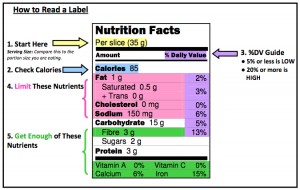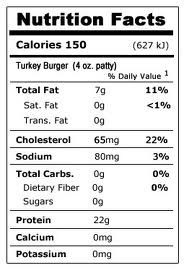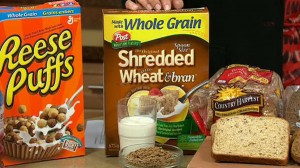Reference: Government of Canada:
(http://www.hc-sc.gc.ca/fn-an/alt_formats/hpfb-dgpsa/pdf/label-etiquet/inl-eni-eng.pdf ).
Interactive Nutrition Label Reading and Quiz:
http://www.hc-sc.gc.ca/fn-an/label-etiquet/nutrition/cons/interactive-eng.php
Introduction
You may have noticed that there is nutrition information on many food packages in the grocery store. Canada introduced a new system for providing nutrition information on food labels in 2003. These new regulations are applicable to almost all pre-packaged foods, ensuring the Nutrition Facts table has a consistent “look”, and making it easy to find and read. As of December 12, 2005, most companies are required to have a Nutrition Facts table on their food products.
Nutritional Fact Table: (Click on the table to enlarge)
Nutrition Facts Table (Above)
1) Specific Amount of Food in Grams
2) Calories per serving
3) % Daily Value
4 & 5 ) Core Nutrients
The Nutrition Facts table includes information with respect total Calories and the following 13 nutrients :
1 Fat,
2.Saturated fat,
3. Trans fat,
4.Cholesterol,
5. Sodium,
6. Carbohydrate,
7. Fibre,
8. Sugars,
9. Protein,
10. Vitamin A,
11. Vitamin C,
12. Calcium
13. Iron.
The purpose of the Nutrition Facts table is to help you make informed choices. Making healthy food choices can help reduce your risk of nutrition-related chronic diseases such as cancer,diabetes, heart disease and stroke. Specifically, you can you can use the Nutrition Facts to:
• Compare products more easily
• Determine the nutritional value of foods
• Better manage special diets
• Increase or decrease your intake of a particular nutrient such as sodium
Not all food packages have a Nutrition Facts table
While almost all pre-packaged foods are required to have a Nutrition Facts table, the following are examples of some foods that are exempt from the nutrition labelling requirements:
• Fresh fruit and vegetables
• Raw meat and poultry (except when ground), raw fish and seafood
• Foods prepared or processed at the store (bakery items, salads)
• Foods that contain very few nutrients such as coffee, tea, herbs and spices
• Alcoholic beverages
Steps To Understanding The Nutrition Facts Table:
Step 1: Look at the specific amount of food listed (serving size) and compare it to how much you actually eat.
The amount of food (serving size) will be indicated by a phrase such as: a slice, one egg, two cookies, number of servings per bag.
This will be followed by the measure (size). Familiar household units are usedsuch as ml, cups, g, ounces, tablespoons, or a fraction or unit of food (e.g., ¼ pizza).
Some foods, such as pre-packaged cake mixes, have different methods of preparation. For example, there may be a recipe for reducing the fat content, which in turn alters the nutrient information. For these products, the Nutrition Facts table may have more than one column that provides different nutritional information depending on the way the product is prepared.
The quantity of Calories and Nutrients you consume depends on how much cake you eat and the method of preparation.
Step 2:Use the % Daily Value to see if a food has a little or a lot of a nutrient.
The % Daily Value:
- Allows different product or brand comparisons by determining whether there is a lot or a little of a nutrient in a specific amount of food.
- Based on recommendations for a healthy diet.
- Also lists the actual amounts of some nutrients in grams or milligrams. People with specific dietary needs may need to use these values.
The % Daily Value is best used as:
- 1. A comparative benchmark when deciding between two food products.
- 2. Determine whether the nutrients you are trying to decrease
(e.g., saturated and trans fats, cholesterol, sodium) have low percentages in a food product.
Example: you want to decrease your intake of fat when choosing between two burgers, select the burger with the lowest % Daily Value for fat, specifically Saturated and Trans Fat, per comparable amount of food (130g). In this example the Turkey Burger is the clear winner.
Beef Burger Chicken Burger
Step 3: Look at the calories and core nutrients
Calories and the same 13 core nutrients are always listed in the same order.
1.Calories
If you eat more than the amount of food specified in the Nutrition Facts table, you will also be consuming more calories than what is listed. Portion sizes influence the number of calories consumed.
Example: if the Nutrition Facts table has information based on 1 waffle and you eat 2 waffles, you will need to double the calories and the amount of nutrients listed in order to calculate what your intake would actually be.
2. Fats
The amount of fat listed in the Nutrition Facts table includes saturated fat, trans fat and all other fatty acids present in the food.
Saturated fat and Trans Fat have one combined % Daily Value in the Nutrition Facts table because both types of fat have negative effects on blood cholesterol levels. Therefore, choose lower % Daily Value of fat type foods.
3. Cholesterol
The % Daily Value for cholesterol is optional, so it may or may not be in the Nutrition Facts table. Whether or not the % Daily Value is displayed, the amount of cholesterol will be listed in milligrams.
4. Sodium
Salt is a common ingredient in processed and prepared foods, such as canned soups and processed meats. Most Canadians get more salt than they need so a lower % Daily Value is preferred.
5. Carbohydrates
There are different types of carbohydrates:
Starch such as in pasta and rice.
Fibre such as whole grain products (like whole grain bread, high fibre cereals),legumes (e.g., dried peas, beans and lentils), vegetables and fruit.
Sugars such as sucrose, glucose, fructose and dextrose.
In the Nutrition Facts table, the total amount of carbohydrate is listed for the specified amount of food. This total amount includes starch, fibre and sugars.
There is no % Daily Value for sugars because there is no generally accepted target recommendation for the healthy population. It is generally accepted that less sugar is better.
6.Protein
There is no % Daily Value for protein because protein intake is generally adequate for Canadians who consume a mixed diet.
7. Vitamin A & C and Calcium and Iron
These are based on a recommended daily intake. In the Nutrition Facts table, they are listed only as a % Daily Value, which makes it easier for consumers to understand the relative amount of this nutrient present in a food product.
Other Nutrients
The core nutrients must be listed in the Nutrition Facts table, along with any other nutrients related to any nutrition claims on the package or any nutrients that have been added to the product.
Step 4: Be aware of :
1. Nutrition Claims
The Government has rules in place that must be met before a nutrition claim can be made on a label or advertisement. The rules for nutrition claims apply to all foods pre-packaged and not pre-packaged, no matter where they are sold.
A manufacturer can choose whether or not to include nutrition claims on the label or in the advertisement of a food. Many products will have nutrition claims as these claims highlight a feature of interest to consumers.
Examples of Claims:
1. “Source of Fibre”
This means the food contains at least 2 grams of dietary fibre in the amount of food specified in the Nutrition Facts table.
2. “Low fat”
This, means the food contains no more than 3 grams of fat in the amount of food
specified in the Nutrition Facts table.
3. “Cholesterol-free”
This means that the product has a negligible amount (less than 2 mg of cholesterol in the amount of food specified in the Nutrition Facts table) and it is also low in saturated fat and trans fat.
4. “Sodium-free”
“Free” is an amount of a nutrient so small that health experts consider it nutritionally insignificant. A “sodium-free” claim means the amount of food specified in the Nutrition Facts table contains less than 5 mg of sodium.
5. “Reduced in Calories”
This means at least 25% less energy (Calories) than the food it is being compared to.
6. “Light”
“Light” is allowed only on foods that are either “reduced in fat” or “reduced in energy” (Calories). “Light” can also be used to describe sensory characteristics of a food, provided that the characteristic is clearly identified with the claim (e.g., light tasting, light coloured).
2. Health Claims
Health claims are a type of nutrition claim. Health claims about the following diet/health relationships are permitted:
• A healthy diet low in saturated and trans fats may reduce the risk of heart disease;
• A healthy diet with adequate calcium and vitamin D, and regular physical activity, help to achieve strong bones and may reduce the risk of osteoporosis;
• A healthy diet rich in a variety of vegetables and fruit may help reduce the risk of some types of cancer;
• A healthy diet containing foods high in potassium and low in sodium may reduce the risk of high blood pressure, a risk factor for stroke and heart disease.
Step 5: Read the List of Ingredients
The list of Ingredients on food packaging is mandatory. All of the ingredients for a food are listed in descending order by weight. The ingredients present in the greatest amount in a product are listed first.
Example: wheat flour is the ingredient present in the greatest amount on the List of Ingredients below, since it is listed first.
The list of ingredients is also a source of information for people who want to avoid certain ingredients or verify the presence of an ingredient in a food such as sugars. The Nutrition Facts table gives the content of sugars from all sources (naturally occurring sugars and added sugars, if any). To find out if sugars have been added, you need to look at the ingredient list. Examples of sugars include: corn syrup, dextrose, fructose, glucose, malt syrup, invert sugar and concentrated fruit juice.
Summary
The Nutrition Facts table is an excellent source of information about nutritional value of foods based on portion size. It can be used to monitor total caloric intake, fat, sodium and cholesterol intake and help identify foods high in fibre, vitamins and minerals. Identical foods from two different manufactures can have significantly different nutritional make-up (one can be high in sodium and the other low) and it is well worth the time and effort to determine which one has the highest nutritional value. Good nutrition starts with reading the Nutrition Facts table on the packages on the food you buy.
If you’d like more info please contact Mike.







